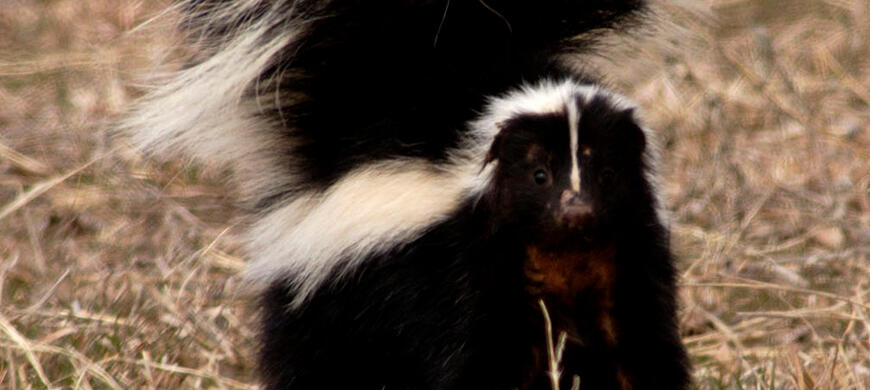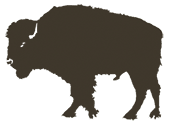Striped Skunk

The striped skunk ( Mephitis mephitis) is an adaptable member of the weasel family that exists throughout Kansas. Striped skunks are most often found in agricultural fields, pastures, woodlots, and associated fence rows, brushy edges, and rocky outcroppings. They also take advantage of food and denning sites provided by people, and are commonly found in urban and suburban areas where they are usually considered a nuisance. They are least common in the arid southwestern quarter of the state.
Striped skunks are easily recognized by their contrasting white stripe on otherwise black pelage, but there is considerable variation in the width of the stripe. Skunks may range in color from almost completely black to almost completely white. They are approximately cat-sized and usually weigh from 5-10 pounds, with females being slightly smaller than males. They have a large, bushy tail, a small head with beady eyes, and long, curved claws on their front feet for digging. As a means of self defense, the striped skunk emits a pungent musk from two anal glands. This bright yellow fluid causes severe discomfort when striking the face of a would-be predator turned victim.
Among the most den-dependent furbearers, striped skunks are capable of digging their own burrow, but usually remodel abandoned badger or woodchuck dens if available. They also take up residence in or under man-made structures including dumps, junkyards, rock fences, woodpiles, and buildings. They are especially reliant upon underground dens in the winter when they become inactive. Communal denning is common at this time, with a single dominant male taking up residence with as many as a dozen or more females. It is to the male’s advantage to be in close proximity to many females during this time, since the short breeding season occurs at the first sign of warm-up in late February or March. Reproductive rates are high, with an average of six kittens being born in late April or May.
Grasshoppers, beetles, and other insects make up the bulk of the striped skunk’s diet, but mice, rats, carrion, ground nesting birds and eggs, corn, and various types of plant matter are also consumed. Prey is often acquired by digging, and is usually located by the skunk’s keen sense of smell.
The annual turnover rate is high for striped skunk populations. Few skunks live past the age of three. The great horned owl is a primary predator, although coyotes, badgers, and other carnivores also occasionally prey on adults. Predation of kittens by badgers and adult male skunks has been documented, and starvation during winter denning may sometimes be an important source of mortality. Skunks are susceptible to several diseases including canine distemper and most notably, rabies. In Kansas, the striped skunk is recognized as a leading rabies vector, often accounting for 80 percent of more of the animals that test positive for the disease each year.
Striped skunks were a staple of the fur trade into the 1950s, but low pelt values limit their importance today. They are easily trapped, but like opossums, most are caught in damage control situations or incidental to the trapping of other species. Recent annual harvests of 5,000 to 6,000 have been common, though harvests averaged more than 16,000 during a 5-year stretch in the late 1970s and early 1980s.
Dates: 11/13/2024 - 02/28/2025
NOTE: All furbearer hunting, trapping, and running seasons begin at 12:00 a.m. on opening day and close at midnight of closing day.
Species: badger, bobcat, mink, muskrat, raccoon, opossum, swift fox, red fox, gray fox, striped skunk, weasel.











